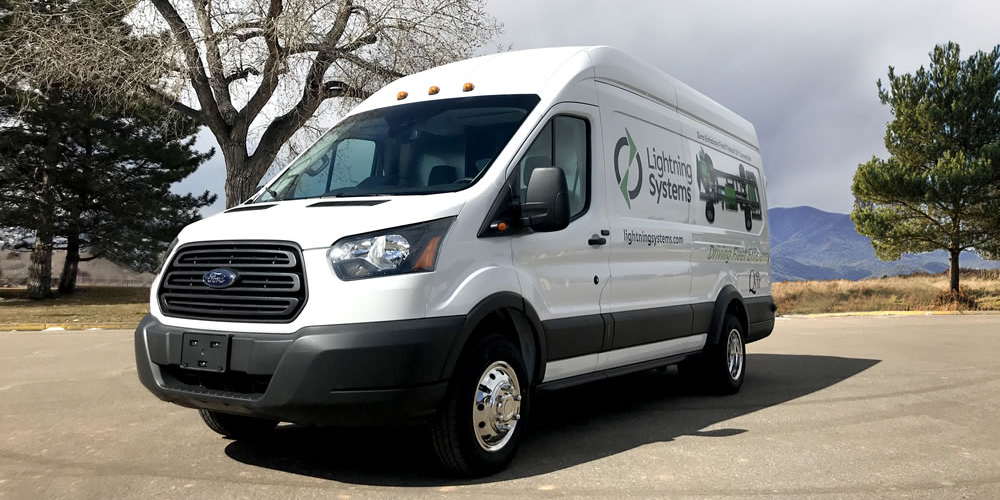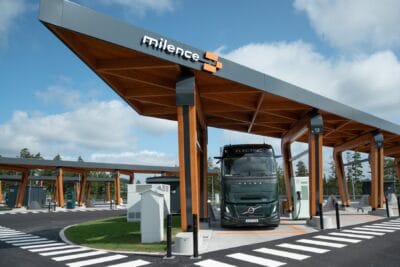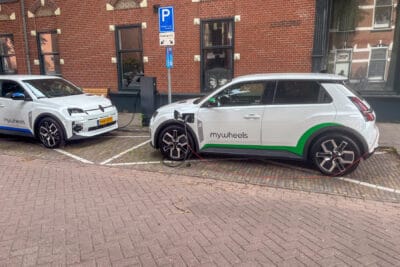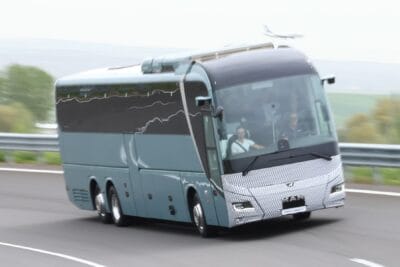Interview: Barton Sidles from Hubject on the Advanced Clean Trucks (ACT) in California
In an online meeting between Berlin and Los Angeles, Carrie Hampel interviewed Hubject’s Senior Director of Corporate and Business Development Barton Sidles about the new Advanced Clean Trucks (ACT) rule set by the California Air Resources Board (CARB).
California requires manufacturers to sell a gradually increasing proportion of electric trucks, vans and pickup trucks from 2024 onwards until 2035. By the year 2045, every new commercial vehicle sold in the US state should have zero-emission propulsion according to ACT regulation.
This means businesses and municipalities now have a calculable time frame by which they will have to electrify their commercial vehicle fleet. Hubject provides a platform that is among the biggest international digital B2B market places for services related to the charging of electric vehicles as well as consulting for businesses electrifying their fleets.
Electrive: Firstly to ask you about Hubject – what are the main aspects relevant for Hubject regarding the Advanced Clean Trucks rule?
Barton Sidles: So what we are doing is looking at the world of the Advanced Clean Truck regulation, the ACT regulation. It’s looking at companies, primarily fleets, even municipalities and how they can take advantage of this expanded vehicle options that are coming onto the market. Hubject is helping companies that are looking to assess the options for vehicles and the total cost of ownership, including operational costs and the savings that battery electric vehicles can offer. And then on top of that, the charging itself.
One key aspect that Hubject seems to approach, is for businesses to get their business models compatible at the beginning stages so that they don’t have larger costs later. Can you explain a little bit about that?
Sure. So this has do with looking at the client’s needs and being able to project the building of the business model and use cases for their needs. I’ll give you an example where we are looking at the routes. So routes are very challenging right now because it goes back to the vehicles and what is available. The options that we have and where the ACT is beneficial for fleet owners is that this is going to increase not only the number of (zero-emissions) vehicles but the options of vehicles – probably sooner than people thought because of the OEMs being penalised if they don’t.
So the challenges with that right now are, let’s say that they have a client has stem miles, that they are kind of lost. That means that the depot is outside of the city centre. They have 40 to 50 miles that they’re just driving before they even get to the first client. So therefore if they have, let’s say approximately a hundred miles that they need to drive, and then another 50 back that’s 200 miles. Well, there aren’t many vehicles that offer that range right now.
So what do they do?
Then it is saying, let’s have some partnerships. Maybe there is a location where the unloading of the products is long enough that maybe a DC fast charger there would make sense for the vehicle to charge. I’ll give you an example. Let’s say a hospital has many different deliveries to it that might say, okay, well then we might be able to provide this service to some of our other clients because we’re using electricity, reducing greenhouse emissions is an overall plus for our sustainability initiatives. So this is where I’m listening to clients, looking at the long term, looking at what their needs are. We talk to our clients about looking at this from use cases and growth of the business.
Do you see collaborations between, let’s say supermarkets, for example, and logistics companies with the charging infrastructure?
Absolutely. Grocery stores are a fine example in two cases: One is on the B2B side. So delivery of medium or heavy-duty vehicles when you’re offloading produce, the vehicle is sitting there when it’s being offloaded. But also then you have the more B2C the business to the consumer side, where you’re already seeing right now, collaborations with Electrify America to other charging networks, even go with the likes of Walmart or with Wholefoods. And you’re going to see that more and more, especially when there’s a need for some of these charging networks to provide the charging infrastructure to its members, but also as the electric vehicle numbers grow. So there are lots of opportunities for collaboration, and it helps spread out a little bit of the costs as well.
There are incentives for a business for getting supported for electricity charges and vehicle costs, but what about their charging infrastructure?
Yeah, there are incentives for charging infrastructure, for sure: Incentives for the infrastructure leading up to the charging, to the charging unit and then also incentives for the actual charging station itself. There’s various rebates or programs that some of the utilities are offering. Take the example of California, that they have approved incentives for installing electric infrastructure to the customer site up to the charging station, and they can offer vouchers for the charger themselves. And in addition to that, there’s also the newly established electricity rates for commercial zero-emission vehicle rates. So they’re really trying to help them throughout that whole process.
How relevant is hydrogen at this stage for Hubject when you’re advising businesses – do you stick to battery-electric or is the hydrogen economy already relevant?
In the Advanced Clean Trucks rule, it’s relevant for a more specific class. We’ve got some clients that are interested in converting some of their vehicles that have a longer route. And there just is not the BEV, the battery-electric vehicle options out there right now. So, absolutely – hydrogen is an interesting solution for the right use case.
If there’s a business owner saying, okay, well, I’m going to electrify my fleet and I’m looking at charging, but I don’t want to get caught out if the grid’s down that I can’t charge my vehicles and that my business effectively stops. Maybe you can talk more about how business owners protect themselves against being without power basically, also when looking at California’s grid problems.
We are going through a heatwave and unfortunately, a lot of forest fires. And because of that, because of the heat, electricity use and air conditioning is going up. Yes, you’re absolutely right there, that is an important part of the equation. But interestingly enough, with the increased number of electric vehicles, there will be more energy demand, but as we see more that the demand can be balanced when you have a smart grid. And that’s where California’s moving towards, to shift the load to off-peak periods. This increased demand will also make the grid more efficient. And this is something that the CPC, the California Public Utility Commission is very conscious of.
But what does that mean for vehicle owners?
The advantage with electric vehicles is being part of this. And with the medium and heavy-duty is then you get into some really interesting areas, like a district integrated distributed energy resources, IDER – the input of electricity from the grid from renewables, but also can be from battery storage. Adding electric vehicles as part of the IDER solution – you have not only smart communication through smart charging of two-way communication, but then you have two-way energy flow (V2G).
So all of a sudden you have a fleet company that has this core business of transporting people or goods from point A to B, but then you also have this amazing opportunity for them to be energy providers.
So how would a business become a part of that?
A lot of times when we’re working with our clients fleet companies, we have to take a look at what is their requirement? What are we looking at in terms of the miles driven their routes and the use of the time and the use of the vehicle, because it could be, you know, for example, a school bus has use in the morning, but then it has a break. So, therefore, it could be charging and using solar at that time. And then it will use again in the afternoon and then be able to charge in the evening. So, the idea is that, of course, the grid is extremely important. And I think that blackouts or not having any electricity generation for a longer period of time creates a challenge, no matter what kind of, transportation mode you have, whether it’s ICE or electric, but battery storage and solar will all be part of it.
I mean, there’s a lot of different setups that you could have, but then it could also be back into a microgrid environment.
Potentially does that mean if the main grid does go down a microgrid is still operational?
That is the intention. In terms of the energy California, and a lot of other States are moving towards renewable. And Governor Newsom has actually said renewables are difficult because they can’t ramp up like we have now. So I think that transportation and the energy source have to grow together. But also, you’re absolutely right, I see that there’s the microgrid where, a fleet of, let’s say 50 to a hundred vehicles, all of a sudden has quite a bit of energy to provide, especially in the evening time when that’s, the cars are already full and then to be able to feed into a microgrid.
I think that that is that’s overall, like what we’re working with clients and saying, how can we incorporate this first in your micro-environment of a, let’s say, a factory or a depot, and where you might have solar already. So this is all an integrated process, the electricity generation, and then the electricity use through the vehicle.
Hubject has been instrumental in enabling the ISO 15118. Can you say a few words about that?
ISO 15118 involves plug & charge capabilities, even smart charging. So the ISO 15118 is a protocol that is strictly related to the secure communication between the charging station and the electric vehicle.
As you probably know, Porsche Taycan, the Ford Mach-e, then you’ve got the Audi e-tron and other vehicles that are coming out with it. It’s just very easy to plug it in and the authentication, so the security aspect, happens and that’s very good for the smarts of the vehicle, the smarts of the hardware, the charging station, and also the smarts of the grid. We’re starting to talk about the idea of the technology – the protocol – being able to offer, plug & charge, smart charging, and then bi-directional. When you’re talking about bi-directional and the idea of a certain amount of electricity going back into the grid, you want to make sure that that is authenticated, that that is trusted.
And, from what you were also talking about (plug & charge) with fleets, this means that you don’t have to have additional cards for charging and everything is already inside the vehicle. So it becomes a handy tool, say the fleet managers to make one thing less that drivers to have to deal with.
As you mentioned the examples of the vehicles that are compatible with plug & charge – I wondered to what degree are commercial vehicles prepared for this technology?
You’re right, it is happening now initially with more passenger vehicles. And, I think that this, at least for the communication is going to be happening more and more. You might be aware that there’s a group called CHARin. It’s actually based the headquarters global headquarters are in Berlin. This organisation is focusing on supporting the CCS standard. And this organisation has also been a driving force behind a high power charging group to define the charging standard for commercial vehicles. And this is going to be based on CCS, which is also compatible with ISO 15118. So I think you will see these companies and the technology is moving into the commercial space. It’s just because, right now there hasn’t been the options and the volume of the commercial vehicles, but it will be a tool that they will start to use in the future.
So, for businesses with vans and trucks, that means they’re buying new vehicles that aren’t yet being kitted out with this technology that will be more useful in the very near future.
I totally get it. And it’s a question that often comes up from the industry and hardware manufacturers, whether it’s from the charging side or the vehicle side. So it makes it a little simple because it’s not retroactive. This technology is really kind of from today going forward and current charging infrastructure can be upgraded with some hardware and software. So then that’s just going to be a business question for some of the VSC manufacturers. Also, we are working with Tritium that is providing the charging networks for Ionity in Europe. And here in the States, we’re working with Electrify America and GreenLots will be the first two charging networks that will be ISO 15118 plug & charge enabled.
Lastly, what are you personally most excited about in the next year?
For me, I think it is really the options that are coming on the market. And this is both from a consumer side, but even more on a business side, the commitments that we’ve seen from Amazon and these exciting new companies like Rivian that are challenging the legacy companies. There are more opportunities on the market for people to feel more comfortable saying, okay, now I get it.
Also battery: The whole total cost of ownership is very important. I think that once people get in pilot projects and experience that, the penny will drop faster for others to understand, how and why that makes sense and to expand one or two pilot projects into a much larger program.
So you say that this is for all sizes of businesses, that this is already a good scenario for economic benefit. Do you see it that way?
Yes, absolutely. I think that you see this excitement on where this spills over. In the ACT regulation CARB has estimations of billions of dollars of incentives of economic benefits that will come about from economic savings and from health benefits. And so I think that the sustainability aspect of this will resonate more with companies when they see it a bit more tangible and reachable. So I think that, again, it’s going to be a little bit more in front of people that will start the snowball effect. And that’s where that becomes very exciting.
Thank you very much for your time!





0 Comments